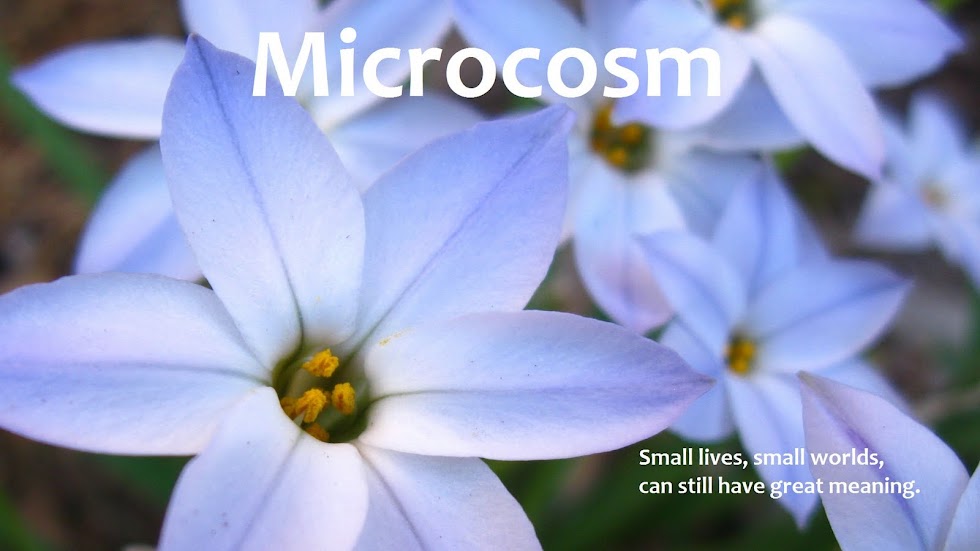Outdoor thermometers—the old-fashioned kind, not the digital kind—may be accurate as to temperature, but they're misleading about experience. That line of red creeping bit by bit up the scale, filling the space slowly from bottom to top, gives you the idea that temperatures ease gradually into one another. Since the hot temperature marks are right next to the warm ones only higher, surely a hot day should feel like a warm one, only more so.
When you're standing in blazing sunshine on the west side of a building on a summer afternoon, though, heat is not at all like warmth. It is a whole other animal, one that snarls at warmth and sends it scampering to cower under the covers. It does not fill you with a cozy glow as if from within. It beats at you from without. It is an alien, different from warmth not only in degree (ahaha) but also in kind. It lives by its own rules.
I was thinking about that quantum leap from warmth to heat while wandering around at Plants of the Southwest a while ago. The parking lot at the nursery has a long mixed border filled in an easy-breezy way with dry-climate plants. On a hot, hazy afternoon, the silvery blues and grays of their leaves shimmered like heat waves rising from the gravel. Scattered yellow daisies radiated light like miniature suns. The lavender looked dusty and faded. All but one of the plantings spoke the inarticulate, panting language of heat. The lone exception, the Mexican hats (Ratibida columnifera), gave voice to a poetry of warmth. The flowers' rich mahogany invited heat back into the fold. They reduced it to a human scale and did what they could to tame it. They tethered it to something comfortable and comforting.
A few Ratibida came home with me, where they've taken up residence in the small, central "I Wish I Were a Shortgrass Prairie (But I'm Not)" bed. I trimmed the blossoms off to help the plants settle in, and they are slowly beginning to flower again.
I love watching them bloom. First the cones form, in a pale green that echoes the blue grama grass.
 |
| For some reason this just makes my heart sing. |
A few days later the sterile ray flowers begin to reach out, their petals lined with gold.
Soon the disc flowers come to life.

They mosey slowly on up the cone. Once the whole cone is alight, the ray flowers fade and fall.
Watching them bloom is like watching a fire start. Not a conflagration—not one of the wildfires that have devoured so much of the west this year—but a small fire, a campfire, a cozy warmth rather than the wildfires' white heat. The kindling catches, and flames slowly lick around the smaller twigs and then the larger logs. They sashay on up through the whole stack of fuel until everything is dancing merrily with light and color, and then die back down again to the embers.
Seeing these flowers, you remember that, like fire, heat colored with warmth can be a domestic thing, and a good one. You remember firelit evenings in the mountains when you would watch the shadows playing, and the light shining redly on faces gathered in a circle, where you held out your hands to the flames.
Overhead, almost close enough to touch, the stars would kindle, until the night sky was gently, quietly ablaze.
Ratibida columnifera is one of my favorite garden perennials, so I'll sing its praises in a practical way, too. I've grown Mexican hats before and will only warn against treating them kindly. Given little luxuries like water and compost, they get waist high, and are not welcome in the front of the border. Otherwise, they're 18" tall or so and not quite as wide. In Albuquerque they bloom from roughly the end of May until mid-August or September. Like most long-blooming members of the aster family, they are short-lived, but they self-seed in an easy-going way, so that stands of them can live for a long time. The mahogany-with-yellow form (R. columnifera var. pulcherrima) also has a sister form that is golden yellow (R. columnifera). They grow naturally from Mexico to British Columbia and so can take just about any garden conditions, including cracks in the sidewalk, except extremes of pH and heavy clay. (And kindness.) They like heat and sun, but they're hardy at least to zone 4 if not colder and will still bloom well in light shade. In my morning-sun conditions, these tap-rooted plants need some but not much supplemental water once established; they would no doubt want more in all-day sun in a dry climate (10" moisture or less per year). They're fine in wetter climates where they will probably grow larger. Leaves are finely cut and a good blue-grama-grass green. They grow mostly around the base, not along the stems, so the overall effect is fairly airy. The plants have a winter form that I could take or leave, but the basal leaves stay green. Goldfinches will eat the seeds, if they can get to them before the ants do.























